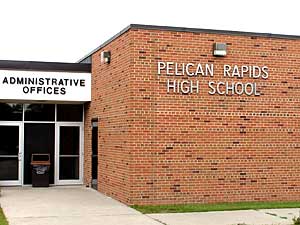|
Photos
More from MPR
Your Voice
|
Pelican Rapids critical of poor report card
August 26, 2004
 |
| Pelican Rapids High School is one of many in Minnesota on the list of underperforming schools released by the state. (MPR Photo/Bob Reha) |
Pelican Rapids, Minn. — The hallways of Pelican Rapids high school are nearly deserted, but the silence is broken by the girls volleyball team. Although classes haven't started, practice for the new season is underway.
Across the hall from the gym, principal Glen Moerke is doing paperwork. Moerke says the state's report cards will contain bad news for the Pelican Rapids High School. Moerke says the school will be on the underperforming list for doing poorly in another category, the AYP, adequate yearly progress.
 | |||
"You get this school report card and it's a five star max. But, if you fail to make any portion of the AYP categories -- and there's 35 to 40 in most schools -- so if you fail in any one of those categories, then two stars is all you're ever going to be," he says. Moerke says adequate yearly progress for high school is judged by five performance goals, including attendance, graduation rates and test scores.
"In our case it's a proficiency issue in reading and math," says Moerke. "It looks like we're going to fall below the standard that we needed to attain, so we'll be on the list."
There are 610 students in the Pelican Rapids High School. Moerke estimates as many as 80 are considered "special ed" students. These are kids with learning disabilities, behavioral or emotional problems, and those problems make learning more difficult for them.
 | |||
Improving the test scores of special ed students isn't the school's only challenge. Another is it's relatively high percentage of students -- 28 percent -- who speak English as a second language. Pelican Rapids has a diverse population -- it is popular with immigrants and refugees who have found jobs at the local turkey processing plant. Last year, Elaine Johnson taught students from places as varied as Bosnia, Mexico and Egypt. She says teaching kids how to read and write English is the easy part. What's difficult is learning that words can have two meanings, especially on a test.
"And it (the test) said that, 'People weighed in on something.' Well, these kids would see that, of course, weigh means how much do you weigh," says Johnson. "They weighed in, they all got on a scale. So the language that is used, within the test, may not be fair for some of the students."
Overcoming language barriers presents another problem. Many of these kids have never been in school before. Principal Glen Moerke says that makes it very difficult to discover if second language kids have learning disabilities.
Moerke is uncomfortable with how progress is defined by No Child Left Behind. He says test scores aren't necessarily an accurate gauge of progress. He remembers two students who had never been to school before. They couldn't speak English, but they were able to pick up basic math.
 | |||
"They were counting on their fingers to get to five you know? Trying to figure out what's three and two. That's pretty basic stuff that you don't see in the high school very often," says Moerke. "These are the same kids that are testing in the math test. There's no way that student is going to have an average test score."
The staff at the Pelican Rapids High School has one year to bring their students' grades up. If test scores don't meet the standards set in the law, penalties could be imposed. If a school is on the underperforming list for two years, a student can ask to transfer out. After three years, parents can ask for individual tutoring.
Superintendent Kent Baldry says if a school doesn't improve in five years, control of the school could be taken away from local officials.
"It all sounds very dramatic and drastic. I don't know how they would ever handle that out in rural Minnesota," says Baldry. "I'm not sure that many school districts would sit back and tolerate someone coming in that they don't know and trying to reorganize their school district."
Baldry says when school officials see the final test results, the teachers and staff will analyze the scores to develop a plan to bring the school in compliance with the law.
|
News Headlines
|
Related Subjects
|
